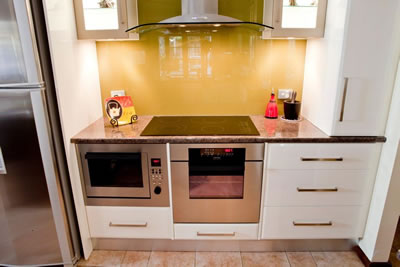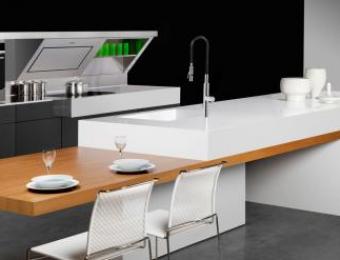
Acrylic splashbacks are the main alternative to tiles and glass these days, and provide a cheap alternative - particularly to glass, which looks quite similar. Acrylic sheets can be cut to specification and coloured to your requirements. The acrylic comes in large sheets, that are cut to your exact specifications. Wherever possible, a single sheet of acrylic is normally used to create a splashback.
What are acrylic splashbacks made from?
Acrylic is a generic name for rigid plastics made from a substance called 'polymethyl methacrylate'. This material has the greatest transparency of any material (even more than glass) and will allow UV to pass right through it, meaning that it won’t yellow over time. Acrylic is used in many applications, including motorcycle helmet visors, large aquariums and the bulletproof ‘glass’ protecting bank tellers.
What are the properties of acrylic?
Acrylic's strong, lightweight and very easy to work with, though can be vulnerable to cracking if it's put under too much pressure. Acrylic can be tinted to change the colour of the light it lets through, creating dazzling effects at different times of the day if it's properly positioned. Acrylic glass also allows 92% of visible light to pass through it. Unlike thick glass which has a green tint, acrylic is clear.
If you're installing an acrylic splashback, the most basic way to achieve a certain colour is to paint the wall behind a clear acrylic in the colour of your choice. Acrylic splashback products do come in various colours, however, and you may find that a coloured acrylic provides a more solid look.
Installation requirements
One of the downfalls of acrylic is that because they're effectively plastic, most acrylics don't stand up too well to heat, and therefore can't be installed directly behind cooktops without some other form of compensation. A 200mm high layer of stainless steel or tiles above the cooktop will provide sufficient protection - although some people may offer for a different type of surface for the entire area behind the cooktop.
Your builder should be able to advise on how you're able to install the acrylic splashback - as well as on any specific conditions for warranties.
Maintenance
Acrylic splashbacks can be cleaned with a damp sponge and a general purpose cleaning agent. Depending on the particular material and how it's been manufactured, acrylic may be susceptible to scratching. While scratches can normally be buffed out, it's worth testing samples before you buy to ensure that the acrylic you're looking at is tough enough for your purposes.
|
Advantages
|
Disadvantages
|





